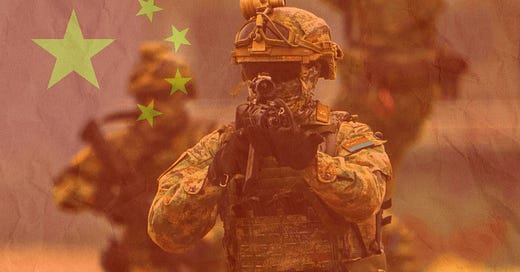Briefing: China's Growing Use of Artificial Intelligence in Millitary Applications
China's Path to Military Dominance through Intelligentized Warfare
Overview
Through its adoption of artificial intelligence (AI) technology in military operations, the People's Liberation Army (PLA) has become an essential force in the worldwide advancement of military modernization. China's ambitions to lead globally in AI by 2030 along with establishing a top-tier military force by 2049 follow the guidelines set in its New Generation Artificial Intelligence Development Plan and its pursuit of intelligentized warfare. The PLA aims to approach any future conflicts through technological superiority by developing AI capabilities that cover autonomous systems together with battlefield awareness logistics and decision-making processes. China has advanced rapidly in military AI deployment compared to other nations like the United States but encounters obstacles related to semiconductor imports and internal organizational weaknesses.
Specific Military Use Cases
Autonomous Systems
The PLA is developing unmanned aerial vehicles (UAVs), ground vehicles, and underwater drones for reconnaissance, logistics, and swarm attacks. These systems could very well rely on AI for autonomous navigation and decision-making.
Notable developments include swarm-capable UAVs and unmanned surface vessels (USVs), such as the JARI USV.
Intelligence, Surveillance, and Reconnaissance (ISR)
AI-enabled ISR systems analyze vast amounts of data in real-time to enhance situational awareness. For example, machine learning algorithms are used to process satellite imagery and detect targets more efficiently.
The PLA has invested in geospatial imagery analysis tools similar to U.S. systems like Descartes Labs but tailored for its own military needs.
Command and Control (C3)
AI-powered decision-support tools improve battlefield coordination by integrating data from multiple sources. The PLA is developing "command brains" to assist commanders in making rapid decisions under complex conditions.
Logistics and Predictive Maintenance
AI is being applied to optimize supply chains and predict equipment failures before they occur. For instance, intelligent warehouses have been established to streamline logistics operations.
Simulation and Training
Generative AI is used for wargaming and training simulations, preparing troops for intelligentized warfare scenarios. Multi-drone swarm simulation systems are a key area of focus.
Electronic Warfare
AI enhances radar target detection, signal classification, and electromagnetic spectrum operations. These capabilities are crucial for countering adversary technologies in contested environments.
Automatic Target Recognition (ATR)
Advances in ATR enable precision targeting by leveraging machine learning models to identify threats in noisy or complex environments.
Impact on China's Military
Enhanced Operational Capabilities
AI integration allows the PLA to conduct multi-domain precision warfare by identifying vulnerabilities in adversary systems and launching coordinated strikes across land, sea, air, cyber, and space domains.
Improved Decision-Making
AI-driven tools reduce the "fog of war" by providing commanders with actionable insights in real-time, enabling faster and more accurate responses.
Force Multiplication
Autonomous systems reduce the need for human personnel in high-risk missions while increasing operational efficiency through automation.
Global Power Projection
The PLA's advancements in intelligentized warfare align with China's broader goal of projecting power beyond its immediate periphery, particularly in the Indo-Pacific region.
Achievements
Rapid Deployment of Autonomous Systems
The PLA has fielded advanced UAVs and USVs capable of swarm operations, demonstrating significant progress compared to other nations.
Military-Civil Fusion Success
Through policies that integrate civilian technology firms into defense projects, China has accelerated the development of dual-use technologies like AI-powered logistics systems.
Advancements Toward Intelligentized Warfare
The PLA's focus on "systems destruction warfare" has enabled it to conceptualize future conflict scenarios where AI plays a central role in achieving information dominance.
Challenges
Reliance on Foreign Semiconductors
U.S.-led export controls on advanced semiconductors have hindered China's ability to fully indigenize its AI supply chain.
Organizational Inefficiencies
Centralized decision-making processes within the PLA may slow innovation and adaptation of emerging technologies.
Lack of Combat Experience
Despite technological advancements, the PLA lacks real-world combat experience with its current suite of capabilities, which could limit its effectiveness in high-stakes scenarios.
Ethical Concerns
The rapid deployment of autonomous weapons without robust ethical oversight raises questions about accountability and unintended consequences during conflicts.
The Road Ahead
Accelerating Research and Development
China will continue investing heavily in AI research across domains like quantum computing, big data analytics, and generative models to maintain its competitive edge.
Expanding Military-Civil Fusion
Further integration of private tech firms into defense projects will likely accelerate innovation while diversifying China's defense-industrial base.
Overcoming Semiconductor Dependence
Efforts are underway to develop domestic semiconductor manufacturing capabilities to reduce reliance on foreign suppliers.
Global Influence Operations
The PLA is expected to expand its use of cognitive domain operations (CDO), leveraging AI for psychological warfare through synthetic media like deepfakes to shape adversary perceptions.
Conclusion
The People's Liberation Army of China is transitioning toward intelligentized warfare by implementing artificial intelligence to secure global military dominance by 2049. The PLA is swiftly updating its military forces to address future combat needs through progress in autonomous systems and enhancing ISR capabilities alongside logistics and decision-making support tools. Short-term ambitions may be restrained by dependencies on imported semiconductors and insufficient field experience. With military-civil fusion policies and strategic technology investments China maintains its position as a significant global defense competitor which requires other nations to keep a close watch in order to preserve their technological advantages.




